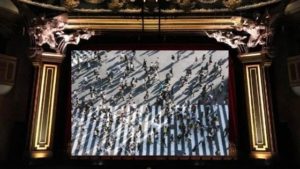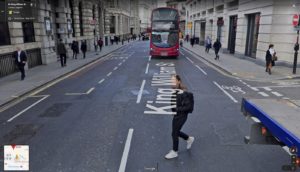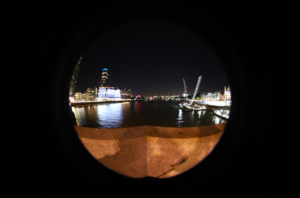
Who do we think of as a threat? How do we perceive our public spaces? How might everyday objects become weapons? Why are some kinds of violence labelled as “terrorism” and others not? How do we think about terrorism and security, and how might art change our perspectives?
In partnership with Eastside Projects gallery in Digbeth, UrbTerr is very excited to announce the launch of a new project, (In)security. An artistic collaboration that aims to respond to these questions, amongst others, (In)security will explore how research can inform artistic explorations of (in)security and terrorism and how research in turn can benefit from the vision and aesthetic impact of art. The project seeks to encourage critical conversations about counter-terrorism measures by exposing and challenging prevailing assumptions about what – if anything – can make us feel more secure in urban spaces. Following an open call, multiple artists working in different mediums have been selected for the project, and will display their work in a public exhibition with a provisional date of December 2020. The various artists’ projects constitute a multi-disciplinary approach to questions of (in)security and terrorism in modern urban spaces, and propose to examine new forms of surveillance and technologies, crime prevention and the use of public space, responding to the differing ways in which these inform our perspectives of urban safety. In tandem with these artistic projects, (In)security is also working with different researchers whose research focusses on security and terrorism at both the University of Birmingham and other institutions, and will in the future inform and be informed by the artists’ contributions. Current researchers are working around questions of security and intelligence, historical perspectives of terrorism, the role of information in counter-terrorism initiatives, and the lives of people who have previously been involved in or have committed acts of terrorist violence.
The five artists who will exhibit their work are:
 Alejandro Acín (b.1984, Spain. Lives and works in Bristol).
Alejandro Acín (b.1984, Spain. Lives and works in Bristol).
Alejandro is an artist, designer and educator. He is interested in how art can make use of archive materials, experimental documentation, CCTV video, text, and invisible & image theatre to reinterpret who we are and the realities around us. He identifies the construction and obliteration of collective memory as a recurrent theme in his work, using experimental approaches to the archive as a means to recognise and counter official narratives in order to generate more complex understandings of certain events. As part of the (In)security project, his work proposes an examination of the concepts of “freedom” and “duty”, using security archives (which is a term he seeks to further define in his work) to explore social invisibility, anti-terror legislation, and the implementation of facial recognition technology and its impact on public space. With this, he wants to reflect on historical counter-terrorism measures through a human rights impact assessment highlighting the effects these have had on human rights and freedom of expression.
 Chloe Sami (b.1991, Lambeth. Lives and works in Winchester).
Chloe Sami (b.1991, Lambeth. Lives and works in Winchester).
Chloe is a trained opera singer and holistic artist who devises and performs in alternative operas, recitals and immersive gallery performances. Her work is concerned with the themes of inner narrative, emotion, race, and women’s stories. As part of the (In)security project, she will be looking at the themes of spectatorship, perspective and narrative, collecting case studies of people in Birmingham over the last sixty years in order to identify the “us” in the question “what can make us feel more safe in urban spaces?”. She proposes a new means of thinking about (in)security and particularly surveillance in public spaces that will encourage a de-homogenisation of the prevailing narrative around public safety, in order to identify more personal narratives that may vary according to, for example, race or gender. Taking a cross-disciplinary stance that incorporates her background in opera, Chloe aims to combine primary socio-historical sources with established operatic pieces, approaching the narrative of our everyday lives as staged tableaux in a way that will allow her to examine these multiple views of (in)security and terror in urban spaces.
 Faisal Hussain (b.1977, Birmingham. Lives and works in Birmingham).
Faisal Hussain (b.1977, Birmingham. Lives and works in Birmingham).
Faisal’s work is centred upon taking the archive out of the hands of museums and institutions and inserting it into public space, with a particular focus on South Asian and Muslim communities here in Birmingham. His previous exhibitions have focussed on Islamophobia and racism within the UK and the world, and he is interested in examining anti-racism, anti-terrorism, and the state. As part of the (In)security project, he plans to use sculpture to explore what protective measures in urban spaces could look like in different geometric or architectural forms, taking inspiration from Arabic text. He is interested in the urban planning processes behind the creation of these protective barriers, and in the ways they may vary between different cities. His work on this project will also address the use of language, and particularly the language of migration, in public spaces. This area of his work will focus on the rise of political parties such as UKIP and the ongoing discourse surrounding immigration in the UK, using public installations such as shop signage to examine prevailing stereotypes of migration and immigration . Finally, he will also explore how we might protect minority populations from violence in public urban space.
 Tamara Kametani (b.1988, Slovakia. Lives and works in London).
Tamara Kametani (b.1988, Slovakia. Lives and works in London).
Interested in our digital footprints, border politics, privacy and surveillance, biopolitics and the proliferation of technology, Tamara’s previous work has focussed on Google Earth and Streetview and the way they construct certain perspectives around different regions, using aesthetic properties to depoliticise certain parts of the world and the responsibilities that may come with that. She has also used technology in the creation of an Augmented Reality app that simulates the creation of a wall, looking at how group dynamics would play into the experience of border creation and separation. As part of the (In)security project, she aims to address the ways in which surveillance is used in counter-terrorism efforts, and the possible use of facial recognition technology as well as the means of harvesting and managing such data that dictate its uses, such as for example the inherent bias towards people of colour often present in facial recognition software. Primarily, she intends to examine the impact of the controversial Prevent strategy which forms part of the government’s anti-terrorism strategy CONTEST and requires professionals such as teachers and doctors to report when they suspect someone of being “at-risk” of extremism.
 Rebecca Huxley (b.1983, Stoke-on-Trent. Lives and works in London).
Rebecca Huxley (b.1983, Stoke-on-Trent. Lives and works in London).
An artist and researcher, Rebecca is interested in investigating social, ecological and political conditions that mediate human experiences of night-time. Her previous work has focussed on themes of light and its manipulation, astronomy, and different understandings of darkness and night. In particular, she is interested in the way we measure darkness and the presence of imperceptible light and the ways we might study something without, in the process, making it vulnerable to harm. As part of the (In)security project, she aims to continue this work on light and dark by examining dark spaces and light pollution in cities, and the way artificial light has been used as a means of Othering certain populations in urban space. Her work will examine the use of CCTV surveillance and artificial lights in cities, exploring the formation of an imperceptible architecture that acts as an extension of colonial architecture and highlights certain “threats” to public space. She hopes to explore what potential political demands can be made for physical space, social protection and data that could help reshape and reclaim hostile space.

1 thought on “Eastside Projects Artist Collaboration”